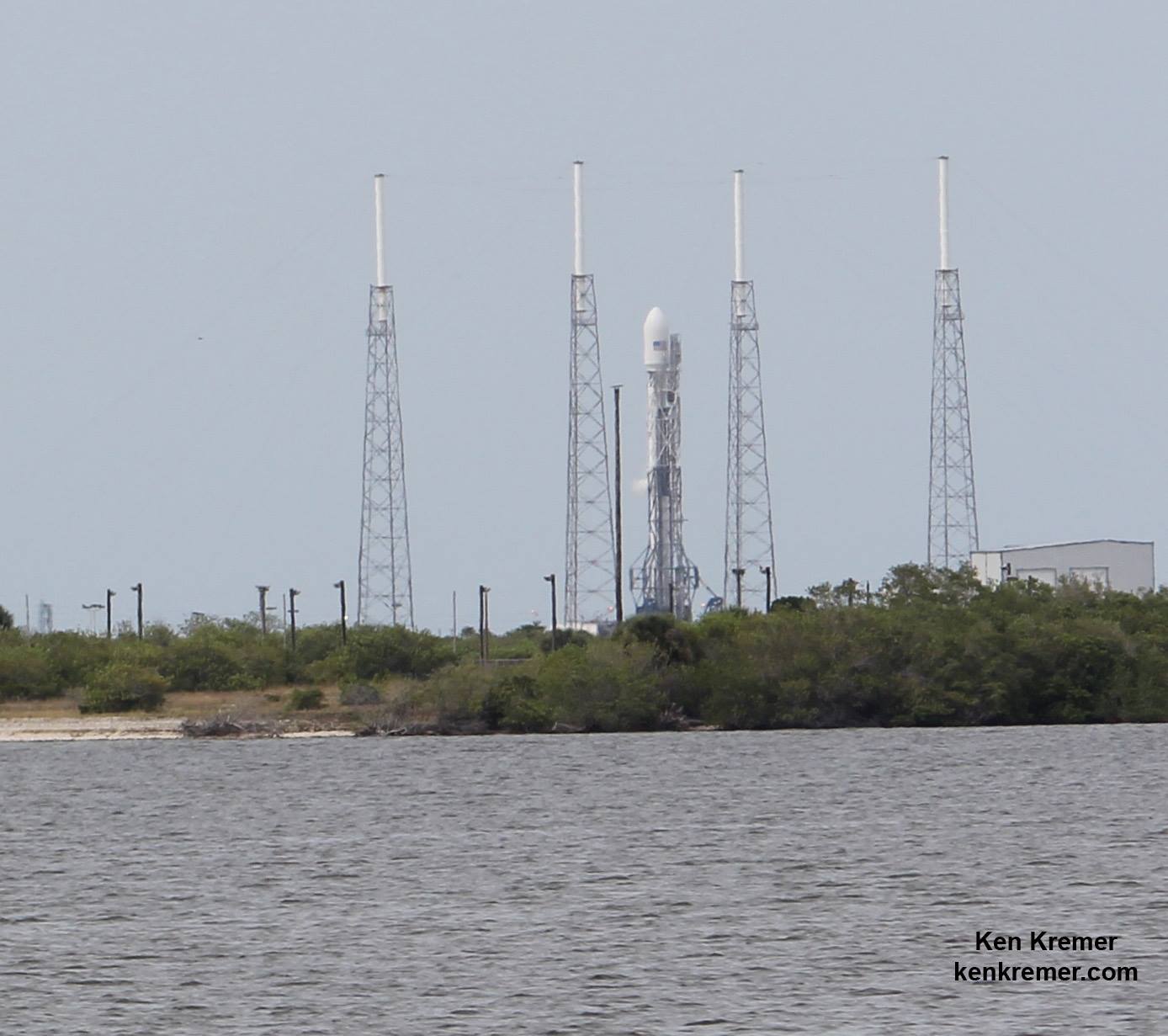
After many delays, SpaceX is ready to launch its fifth Falcon 9 v1.1 rocket on Friday, 20 June, with liftoff currently scheduled to occur at 6:08 p.m. EDT from Space Launch Complex (SLC)-40 at Cape Canaveral Air Force Station, Fla. The mission will deliver no less than six Orbcomm Generation-2 (OG-2) satellites into low-Earth orbit on behalf of Orbcomm, Inc., to provide two-way messaging services for global customers. Originally planned for a May launch, the mission has been repeatedly postponed, due to problems with the Falcon 9 vehicle and, more recently, with one of the OG-2 satellite passengers. According to Patrick Air Force Base meteorologists, the weather situation for Friday and for a backup opportunity on Saturday, 21 June, anticipates “partly cloudy” skies, with a 30-percent likelihood of rain showers and lightning.
Following a failed inaugural launch in October 2012, Friday’s mission will deliver the first six of 17 OG-2 satellites, all built by Sierra Nevada Corp. (SNC), into low-Earth orbit. The remaining 11—which are currently undergoing final processing at SNC—are expected to fly aboard another Falcon 9 v1.1 in November 2014. Orbcomm announced in May 2008 that SNC would build 18 OG-2 satellites for a fee of $117 million, with an option for up to 30 others. A few weeks later, Orbcomm selected Argon ST, a subsidiary of Boeing, to develop advanced communications payloads to increase subscriber capacity by up to 12 times over earlier satellites, as well as transmitting data at higher speeds and quantities. Designed with Automatic Identification System (AIS), it is expected that the OG-2 network will be marketed by Orbcomm to U.S. and international coast guards and government agencies, as well as private security and logistics companies.
At the time of writing, 45 Orbcomm satellites have been delivered into orbit since July 1991, aboard a wide range of vehicles, including Europe’s Ariane 4, the air-launched Pegasus booster, Orbital Sciences Corp.’s Taurus, China’s Long March 4B, India’s Polar Satellite Launch Vehicle (PSLV), and Russia’s Cosmos-3M. Initial “Concept Demonstration Satellites” led to the OG-1 network and a replenishment series of “Quick Launch” missions, with the OG-2 series intended to supplement and eventually replace the first generation. “Due to their high efficiency and modular design, these satellites have substantially more capacity to service a larger number of subscribers, thus making the network more efficient with few satellites than the OG-1 satellites that are currently in orbit,” explained Pat Remias, SNC’s Space Systems senior director of programs. “SNC has established a satellite production line in our Louisville facility to integrate and test each vehicle rapidly, with up to six satellites processing simultaneously.”
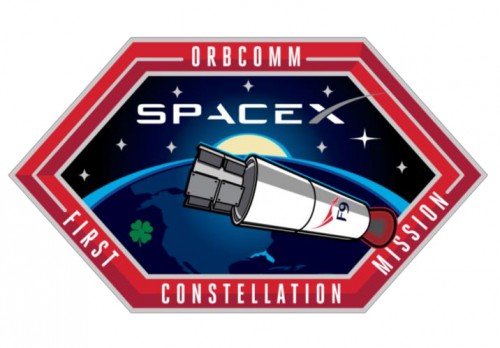
By 2009, Orbcomm had settled on SpaceX’s Falcon 9 as its vehicle of choice, with the inaugural launches originally anticipated the following year, but postponed several times due to delays and schedule slips. The first OG-2 “prototype” satellite was launched in October 2012, flying “piggyback” alongside SpaceX’s CRS-1 Dragon. However, an upper stage engine shortfall caused it to be inserted into a low orbit of just 125 x 200 miles (200 x 320 km), instead of the planned 220 x 470 miles (350 x 750 km). Despite the successful deployment of the satellite from the final stage of the Falcon 9, it quickly became clear that the low orbit was “unworkable” and the first OG-2 re-entered the atmosphere to destruction a few days later.
In preparation for the next batch of OG-2 launches, four satellites arrived at Cape Canaveral Air Force Station from SNC shortly after noon EDT on 21 April 2014, followed by two others on the 26th. Each satellite weighs 380 pounds (172 kg) and, when fully deployed in orbit, will measure 42.7 feet (13 meters) x 3.3 feet (1 meter) x 1.6 feet (0.5 meters) and generate about 400 watts of electrical power. The satellites underwent extensive checks and fueling of their hydrazine attitude-control systems, and on 6 May SpaceX performed a Flight Readiness Review and confirmed its status as “Go” for launch on the 10th. The payload stack, containing the six satellites on their Expendable Launch Vehicle Secondary Payload Adaptor (ESPA) “ring,” was subsequently encapsulated within the bulbous Falcon 9 v1.1 fairing and attached to the rocket.
Rollout to SLC-40 occurred early Thursday, 8 May, after which SpaceX intended to conduct a standard static “hot-fire” test of the nine Merlin-1D first-stage engines. However, a considerable helium leak on the first stage caused the hot-fire to be postponed by 24 hours, then scrubbed indefinitely. “Today’s attempt to perform the static firing test was stopped while the rocket was being fueled,” explained Orbcomm on the 9th. “Both the OG-2 satellites and the rocket are in safe condition and will be rotated horizontal and rolled back into the integration facility. This will prevent us from launching this weekend.” Hardware from the first stage was removed and returned to SpaceX’s facility in Hawthorne, Calif., for inspections and verifications to ensure that the problem did not represent a systemic failure and a threat to future missions.
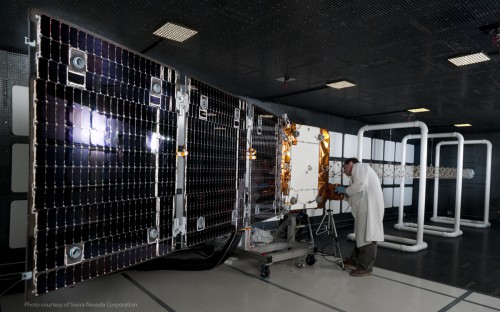
On 19 May, a revised target of 11 June was announced and it was noted that the Orbcomm and SNC processing teams would arrive at the Cape about a week before launch to participate in the lengthy process of re-encapsulating the OG-2 satellites back into their adaptor. By the end of May, the launch had moved a further 24 hours to the right, and on 10 June Orbcomm revealed a new target of No Earlier Than the 15th. “During final integration on one of the OG-2 spacecraft,” it was explained, “we encountered a minor issue resulting in a few extra days of delay to perform precautionary steps to ensure there are no operational concerns with the satellite.” In the meantime, last Friday, SpaceX performed a successful static hot-fire test, but it was feared that upcoming maintenance of Eastern Range tracking assets might result in a further delay until July. However, after “finalizing the launch schedule with the Range at the Cape,” a new date of 20 June was issued.
This will be the fifth flight of SpaceX’s upgraded Falcon 9 v1.1, which undertook its maiden voyage in September 2013. Since then, it has also lofted its first two satellites into 22,000-mile (35,000-km) geostationary orbits: SES-8 in December and Thaicom-6 in January. More recently, in late April, it successfully placed its first Dragon spacecraft into orbit on the third Commercial Resupply Services (CRS-3) mission to the International Space Station (ISS). Two days after launch, the Dragon was successfully captured and berthed at the multi-national outpost’s Harmony node and spent a month in place, prior to a problem-free return to Earth on 18 May.
Assuming a successful countdown on Friday, SpaceX should complete fueling of the Falcon 9 v1.1 with liquid oxygen and a refined form of rocket-grade kerosene, known as “RP-1,” about an hour ahead of the 6:08 p.m. EDT opening of the launch window. At T-13 minutes, a standard poll of all stations will be conducted and, assuming they return a unanimous “Green” (“Go for Launch”), the “terminal countdown” will get underway at T-10 minutes. Now running on the autosequencer, the nine Merlin-1D engines will be chilled down in order to provide pre-launch thermal conditioning. With all propellant tanks aboard the vehicle verified to be at their proper flight pressures, the launch pad’s “strongback” will be completely retracted at T-4 minutes. The Flight Termination System (FTS)—tasked with destroying the vehicle in the event of a major accident during ascent—will be placed onto internal power and armed, and by T-2 minutes and 15 seconds the first stage will be confirmed to be at flight pressure.
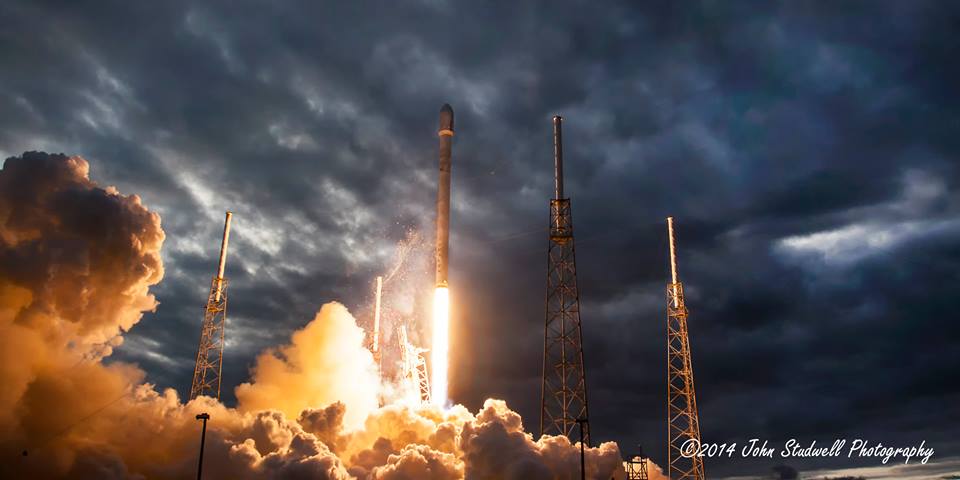
Sixty seconds before liftoff, the SLC-40 Niagara deluge system will be activated, flooding the pad surface with 30,000 gallons (113,500 liters) of water per minute to suppress acoustic waves radiating from the Merlin-1D exhausts. At T-45 seconds, all tanks on the first and second stages will be confirmed at flight pressure. The nine engines will roar to life, ramping up to their required parameters and producing 1.3 million pounds (590,000 kg) of thrust as the Falcon 9 v1.1 bids farewell to SLC-40.
The power of the upgraded Falcon’s Merlin engines is about 200,000 pounds (90,000 kg) greater than those of the earlier Falcon 9 v1.0 and will push the vehicle uphill for the opening 180 seconds of the flight. Their propulsive yield will gradually rise to 1.5 million pounds (680,000 kg) in the rarefied high atmosphere. “Unlike airplanes, a rocket’s thrust actually increases with altitude,” noted SpaceX. “Falcon 9 generates 1.3 million pounds of thrust at sea level, but gets up to 1.5 million pounds of thrust in the vacuum of space. The first-stage engines are gradually throttled near the end of first-stage flight to limit launch vehicle acceleration as the rocket’s mass decelerates with the burning of fuel.”
With around 1,970 seconds of test time and a lengthy qualification program, SpaceX has expressed supreme confidence in the Merlin-1D. During a full-duration-mission firing in June 2012 in McGregor, Texas, the engine operated at or above the power and duration required for a Falcon 9 launch. The Merlin-1D has a vacuum thrust-to-weight ratio in excess of 150:1, making it the most efficient liquid-fueled rocket engine in history. The ignition system for the v1.1’s first stage was tested in April 2013. The stage also includes four extendible landing legs, manufactured from carbon-fiber and aluminum honeycomb, to support a series of tests which SpaceX CEO Elon Musk hopes will lead to vertical-takeoff-vertical-landing (VTVL) capability by the latter half of the present decade. Although SpaceX intends to demonstrate the performance of the legs during ocean splashdown, it has repeatedly stressed that this system remains “experimental” and carries only a 40-percent chance of success in the early tests.
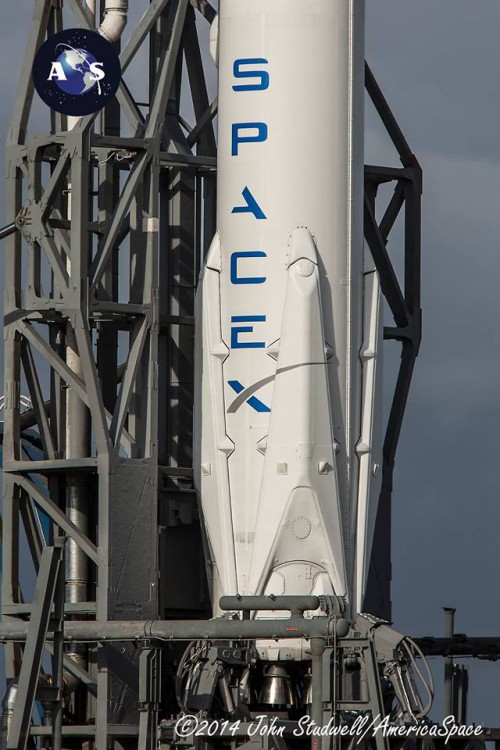
Immediately after clearing the SLC-40 tower, the Falcon 9 v1.1 will execute a combined pitch, roll, and yaw program maneuver to establish itself onto the proper flight azimuth for the injection of the six OG-2 satellties into low-Earth orbit. Eighty seconds into the ascent, the vehicle passed Mach 1 and experienced a period of maximum aerodynamic stress (known as “Max Q”) on its airframe. Two minutes after launch, as planned, two of the nine engines will shut down to reduce the rate of acceleration, ahead of Main Engine Cutoff (MECO) and separation of the first stage. The remaining seven Merlin-1Ds will continue to burn hot and hard, finally shutting down at T+2 minutes and 58 seconds, and the first stage will be jettisoned five seconds later. The turn will then come for the restartable second stage, whose single Merlin-1D Vacuum engine, with a maximum thrust of 180,000 pounds (81,600 kg), will deliver the OG-2 satellites into orbit. Operating from an operational, circular orbit of 460 x 460 miles (750 x 750 km), inclined 52 degrees to the equator, the six satellites are expected to remain operational for at least five years.
This mission is also expected to add further data points to SpaceX’s much-publicized plan to make the Falcon 9 v1.1 fully reusable and capable of returning to a soft touchdown on land. During the CRS-3 ascent, the rocket’s first stage performed a propulsive return-over-water “burn” and deployed its four landing legs to execute a “soft” splashdown in the Atlantic Ocean. Despite a 40-percent probability of success and the added risk of rough seas, the attempt went well and the first stage landed safely and vertically. Significantly, the excessive and uncontrollable roll motions which foiled the first soft-splashdown attempt during the Falcon 9 v1.1’s maiden voyage in September 2013 were notably absent, with recorded roll rates close to zero. “Data upload from tracking plane shows first-stage landing in Atlantic was good,” tweeted SpaceX CEO Elon Musk. “Flight computers continued transmitting for 8 seconds after reaching the water. Stopped when booster went horizontal. Several boats en-route through heavy seas … ”
Although a touchdown on land is not yet planned, SpaceX hopes to continue refining its capability to touch down on water to gradually mature the capability. During Saturday’s OG-2 launch, shortly after the burn-out and separation of the first stage, it will execute a maneuver with its cold-gas attitude-control system to establish an “engine-forward” orientation. Three of the nine Merlin-1Ds will briefly fire to effect braking during the re-entry process, and the four landing legs will be deployed using high-pressure helium once in atmospheric flight. The legs span 60 feet (18 meters) when fully deployed, and the entire assembly weighs about 4,400 pounds (2,000 kg). Assuming that the vehicle does not fall victim to excessive roll motions, the center Merlin-1D will ignite shortly before it makes a gentle impact with the Pacific Ocean.
Should the OG-2 launch go ahead on Friday, or on its backup date of Saturday, it will mark SpaceX’s third Falcon 9 flight of 2014. Three Falcon 9s were also flown in 2013, following on the heels of just two in 2012 and two in 2010. However, Musk anticipates 2014 to accomplish as many as seven more Falcon 9 missions, delivering three Dragon cargo craft to the ISS and deploying a pair of AsiaSat communications satellites, the remaining 11-strong batch of OG-2 satellites, and Turkmenistan’s first satellite. According to Spaceflight101, the AsiaSat launches are anticipated to occur later this summer, with the CRS-4 Dragon expected to fly in mid-August.
Want to keep up-to-date with all things space? Be sure to “Like” AmericaSpace on Facebook and follow us on Twitter: @AmericaSpace
Missions » Commercial Space » ORBCOMM » SpaceX OG2 M1 »



This should lay to rest the idea that Orbcomm is unhappy with SpaceX as some have suggested here in the past.
Nowhere has any of our writers suggested what you’re accusing, Ken, and the simple fact that ORBCOMM is even letting SpaceX fly OG2 is proof enough of their loyalty to SpaceX. No story required…